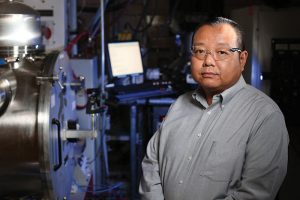
Materials research will make electric motors more efficient, cost effective
Can electric steel, a popular material that’s already a key functional material for modern society, get better? Jun Cui, an associate professor of materials science and engineering and a senior scientist at the U.S. Department of Energy Ames Laboratory, says it can.
That’s why he’s leading a team of researchers who want to increase the amount of silicon in electric steel to 6.5 percent. If the group succeeds, the new steel can be used as the stator material to create an efficient, sustainable, non-rare-earth electric motor.
The team is currently working on a project that would advance electric steel to be used in the motors of electric vehicles. The work is supported by a three-year, $3.8 million grant from the DOE’s Vehicle Technologies Program.
Cui says using electric steel to develop the magnetic stator core of a motor can reduce eddy currents and heat and power loss in the motor. The motor would then be able to run at higher frequencies and have a higher power density, resulting in a smaller, more efficient motor.
To get to this point, the team has to overcome an issue with electric steel – it becomes brittle once you reach more than 4 weight percent silicon.
“When iron atoms are being mixed with a large number of silicon atoms, the brittleness comes from the silicon atoms having time to find each other and pair up,” Cui explains. “To bypass this brittleness, we are rapidly cooling the alloy so the silicon atoms have no time to pair.”
The work combines modeling and experimentation, and brings in research partners from the United Technologies Research Center in East Hartford, Connecticut; and the University of Delaware in Newark.
Experts from Iowa State and the Ames Laboratory will also contribute to the project, including Scott Chumbley, a professor of materials science and engineering and scientist for the Ames Laboratory;
Peter Collins, the Alan and Julie Renken associate professor of materials science and engineering and an associate scientist of the Ames Laboratory; Iver Anderson, a senior metallurgist for the Ames Laboratory and an adjunct professor of materials science and engineering; Valery Levitas, a Schafer 2050 Challenge Professor of aerospace engineering and an associate scientist of the Ames Laboratory; Frank Peters, an associate professor and associate chair of operations in industrial and manufacturing systems engineering; and Matthew Kramer, director of the Ames Laboratory’s Division of Materials Sciences and Engineering and an adjunct professor of materials science and engineering.